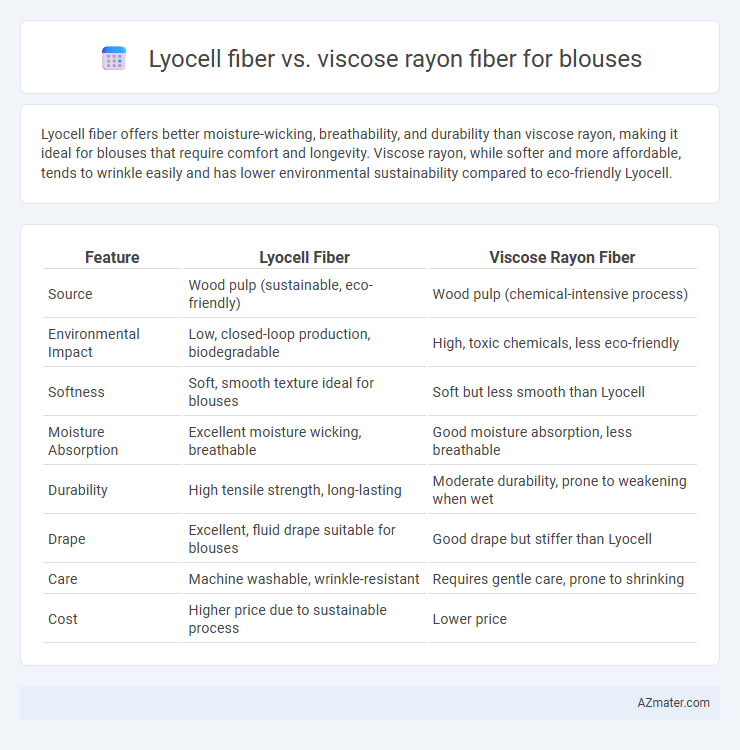Lyocell fiber offers better moisture-wicking, breathability, and durability than viscose rayon, making it ideal for blouses that require comfort and longevity. Viscose rayon, while softer and more affordable, tends to wrinkle easily and has lower environmental sustainability compared to eco-friendly Lyocell.
Table of Comparison
| Feature | Lyocell Fiber | Viscose Rayon Fiber |
|---|---|---|
| Source | Wood pulp (sustainable, eco-friendly) | Wood pulp (chemical-intensive process) |
| Environmental Impact | Low, closed-loop production, biodegradable | High, toxic chemicals, less eco-friendly |
| Softness | Soft, smooth texture ideal for blouses | Soft but less smooth than Lyocell |
| Moisture Absorption | Excellent moisture wicking, breathable | Good moisture absorption, less breathable |
| Durability | High tensile strength, long-lasting | Moderate durability, prone to weakening when wet |
| Drape | Excellent, fluid drape suitable for blouses | Good drape but stiffer than Lyocell |
| Care | Machine washable, wrinkle-resistant | Requires gentle care, prone to shrinking |
| Cost | Higher price due to sustainable process | Lower price |
Introduction to Lyocell and Viscose Rayon Fibers
Lyocell fiber, derived from sustainably sourced wood pulp, is renowned for its eco-friendly production process involving a closed-loop system that recycles solvents, reducing environmental impact compared to traditional viscose rayon fibers. Viscose rayon, produced from chemically treated cellulose, offers a soft texture and good drapability but involves more intensive chemical processing and environmental concerns. Both fibers excel in breathability and moisture absorption, making them popular choices for blouses, yet Lyocell's superior biodegradability and strength present a more sustainable alternative.
Origins and Production Processes
Lyocell fiber is derived from sustainably sourced eucalyptus wood pulp, utilizing a closed-loop solvent-spinning process that recycles water and chemicals, minimizing environmental impact. Viscose rayon fiber originates from cellulose, primarily from wood pulp, processed through a chemically intensive method involving carbon disulfide and sodium hydroxide, which generates pollution and higher resource consumption. The clean, eco-friendly production of lyocell makes it a preferred choice over viscose for blouses demanding sustainable fabric options.
Environmental Impact Comparison
Lyocell fiber, produced through a closed-loop process, offers a significantly lower environmental footprint than viscose rayon by using non-toxic solvents and recycling up to 99% of chemicals, reducing water and air pollution. Viscose rayon involves hazardous chemicals such as carbon disulfide, contributing to deforestation and harmful emissions during production, making it less eco-friendly for blouse manufacturing. Choosing lyocell for blouses supports sustainable textile practices by minimizing chemical waste, water usage, and deforestation compared to traditional viscose rayon fibers.
Fiber Structure and Physical Properties
Lyocell fiber exhibits a smooth, cylindrical structure with a high degree of molecular alignment, resulting in superior tensile strength and excellent moisture-wicking properties compared to viscose rayon, which has a more irregular, porous fiber structure prone to swelling and weaker mechanical integrity. The physical properties of Lyocell include higher dimensional stability, enhanced abrasion resistance, and greater softness, making it ideal for blouses requiring durability and comfort. Viscose rayon fibers tend to absorb more water, leading to reduced wrinkle resistance and a tendency to shrink during washing, which affects the garment's longevity and appearance.
Comfort and Wearability in Blouses
Lyocell fiber offers superior moisture-wicking and breathability compared to viscose rayon, making blouses more comfortable for all-day wear. Its smooth texture reduces skin irritation and enhances softness, providing a luxurious feel against the skin. In contrast, viscose rayon tends to absorb moisture but dries slowly, which can lead to discomfort in humid conditions and less durability during frequent wear.
Durability and Longevity of Fabrics
Lyocell fiber exhibits superior durability and longevity compared to viscose rayon, thanks to its stronger molecular structure and resistance to wear and tear. The fiber maintains its strength even when wet, reducing the risk of fabric damage and extending the lifespan of blouses made from Lyocell. Viscose rayon, on the other hand, tends to weaken and lose shape over time, making Lyocell the preferred choice for long-lasting blouse fabrics.
Dyeability and Color Retention
Lyocell fiber exhibits superior dyeability compared to viscose rayon due to its higher moisture regain and smooth fiber surface, allowing for more uniform and vibrant color absorption. Color retention in Lyocell is enhanced by its strong molecular structure, which resists fading and color bleeding after washing and exposure to sunlight. Viscose rayon tends to lose color intensity faster due to its lower fiber strength and higher susceptibility to abrasion, making Lyocell a preferred choice for blouses requiring long-lasting, vivid colors.
Care, Maintenance, and Washability
Lyocell fibers are more durable and resistant to shrinkage compared to viscose rayon, making them easier to care for in blouse fabrics. Lyocell is machine washable at gentle cycles and dries quickly due to its moisture-wicking properties, whereas viscose rayon requires delicate hand washing or dry cleaning to prevent damage and shape loss. Both fibers benefit from low-temperature ironing, but lyocell's resilience allows for more flexible maintenance without compromising fabric quality.
Cost and Market Availability
Lyocell fiber typically commands a higher price than viscose rayon due to its more eco-friendly production process and sustainable sourcing, making it less accessible for budget-conscious blouse manufacturers. Viscose rayon enjoys widespread market availability and affordability, benefiting from established manufacturing infrastructure and high demand in fashion and apparel industries. The cost difference and supply chain maturity significantly influence the choice between lyocell and viscose rayon for blouse production.
Which Fiber is Best for Blouses?
Lyocell fiber offers superior moisture-wicking, breathability, and strength compared to viscose rayon, making it ideal for blouses that require durability and comfort. Viscose rayon is known for its smooth, silky texture and vibrant drape but tends to wrinkle and weaken when wet, reducing blouse longevity. For high-performance, eco-friendly blouses with minimal maintenance, lyocell stands out as the best fiber choice.

Infographic: Lyocell fiber vs Viscose rayon fiber for Blouse
 azmater.com
azmater.com